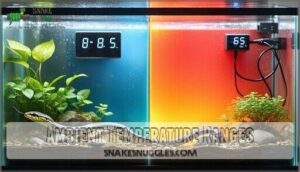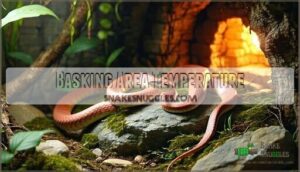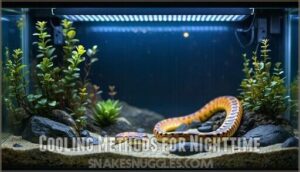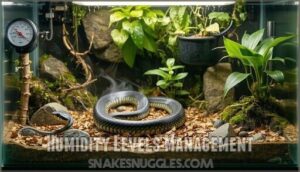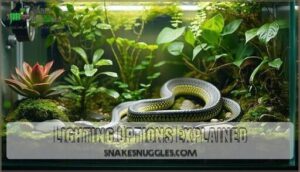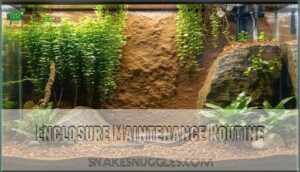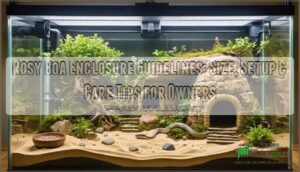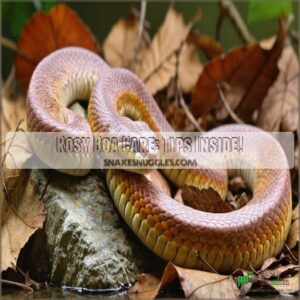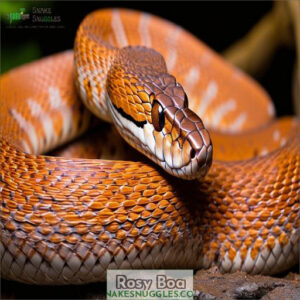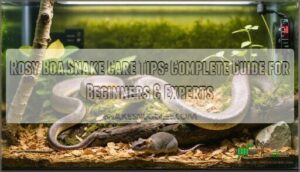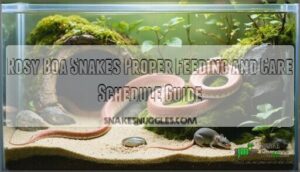This site is supported by our readers. We may earn a commission, at no cost to you, if you purchase through links.
 Your rosy boa snake enclosure setup needs careful attention to create a safe and comfortable home.
Your rosy boa snake enclosure setup needs careful attention to create a safe and comfortable home.
Start with a 20-gallon long tank for adults, using secure glass or plastic with tight-fitting lids.
Add aspen shavings or cypress mulch as substrate, plus multiple hiding spots on both warm and cool sides.
Install an under-tank heater to maintain 75-80°F ambient temperature with an 85°F basking spot.
Keep humidity around 30-40% with occasional light misting.
Include a sturdy water bowl and climbing branches to mimic their natural desert habitat.
The devil’s in the details regarding creating the perfect microclimate.
Table Of Contents
Key Takeaways
- You’ll need a 20-gallon long tank minimum with a secure mesh lid, an under-tank heater, and proper ventilation to create a safe desert habitat for your adult rosy boa.
- Maintain precise temperature gradients with 85-90°F basking spots, 75-80°F ambient temps, and 60-70°F nighttime cooling, using thermostats for consistent control.
- Keep humidity between 30-50% using digital hygrometers and light misting; higher moisture levels cause respiratory infections and skin problems in these desert species.
- Establish regular maintenance routines including daily spot-cleaning, weekly water changes, and monthly deep disinfection to prevent disease and maintain optimal health conditions.
Rosy Boa Habitat Setup
Creating the perfect rosy boa habitat starts with understanding your snake’s desert origins and specific environmental needs.
You’ll need to balance proper enclosure size, ventilation, and safety features to replicate the hot, dry conditions these docile constrictors naturally thrive in.
Enclosure Size Requirements
You’ll need proper tank dimensions to keep your rosy boa happy and healthy. Adult snakes require enclosures measuring at least 48"L x 24"W x 24"H, though cozy spaces work better than oversized tanks for security.
Here’s your size guidelines checklist:
- Hatchlings: Start with 10-gallon tanks for young snakes
- Adults: Upgrade to 20-gallon minimum, preferably larger enclosures
- Space requirements: Length should be two-thirds of snake’s body length
- Enclosure depth: 18-24 inches provides adequate room for natural behaviors
When setting up the enclosure, consider suitable tank size options to guarantee the well-being of your rosy boa.
Material Selection Guidelines
Whatever enclosure materials you choose, glass and PVC tanks offer the best heat retention and visibility for your rosy boa.
These reptile enclosure setup options prevent escapes better than mesh alternatives.
Wood enclosures work too, but require proper sealing.
Plastic faunariums suit juveniles perfectly.
Focus on smooth edges to prevent rostrum damage during your snake enclosure design process.
When selecting materials, consider the benefits of glass tank systems for ideal snake habitat creation.
Ventilation and Safety Features
Your enclosure’s ventilation directly impacts your rosy boa’s respiratory health.
Mesh tops provide superior airflow while preventing escapes, making them non-negotiable for desert species like rosy boas.
Key ventilation and safety features include:
- Secure screening – Fine mesh prevents escapes while maintaining airflow
- Safety lids – Locking mechanisms guarantee your snake stays put
- Heat gradient support – Proper ventilation prevents hot spots and stagnant air
Quality ventilation systems keep humidity below 60% and create the air circulation your rosy boa needs for healthy breathing.
Enclosure Design Essentials
Design fundamentals transform your rosy boa’s living space into a secure, functional habitat. You’ll need to balance practicality with your snake’s natural behaviors to create an environment that promotes health and reduces stress.
Enclosure Materials matter substantially for long-term success. Glass tanks offer excellent visibility and heat retention, while PVC enclosures provide superior insulation and lightweight handling. Snake Racks work well for breeders, but individual terrariums allow for more Bioactive Designs that mimic natural desert conditions.
Ventilation Systems prevent respiratory issues by maintaining proper airflow. Mesh tops with side vents create ideal air circulation without compromising humidity control. Tank Sizes should prioritize security over space – rosy boas feel safer in appropriately-sized enclosures rather than oversized environments.
Proper enclosure maintenance involves understanding optimal space dimensions to guarantee the well-being of your pet.
| Design Element | Minimum Requirement | Optimal Choice | Common Mistake |
|---|---|---|---|
| Floor Space | 20-gallon long | 40-gallon breeder | Too large initially |
| Height | 12 inches | 18 inches | Excessive height |
| Ventilation | Screen top | Cross-ventilation | Poor airflow |
| Hide Spots | 2 hides minimum | 3+ varied hides | Inadequate security |
| Substrate Depth | 2 inches | 3-4 inches | Too shallow |
Temperature Control Methods
Temperature control forms the foundation of rosy boa health, requiring precise thermal gradients that mimic their natural desert environment.
You’ll need to establish three distinct temperature zones: a warm basking area, moderate ambient temperatures, and cooler nighttime conditions to support proper digestion and thermoregulation.
Ambient Temperature Ranges
Your rosy boa needs stable ambient levels between 75°F and 85°F during the day.
The warm side should hit 80-85°F while the cool side stays around 65-75°F.
This thermal gradient lets your snake regulate its body temperature naturally.
Night temperatures can drop to 60-70°F safely.
Use a thermostat with your heat sources to maintain these temperature gradients consistently and create a suitable environment for your pet.
Maintaining proper temperature gradients is essential for creating a suitable temperature control system for your rosy boa.
Basking Area Temperature
Create basking spots between 85-90°F using heat sources like ceramic heat emitters or halogen bulbs.
These thermal gradients let your rosy boa regulate body temperature effectively.
Position heat lamps over one enclosure end, monitoring with digital thermometers.
Proper temperature monitoring guarantees maximal thermal control without overheating.
Heat gradients support digestion and overall health.
Effective snake enclosure temperature control involves creating a thermal gradient with proper temperature zones management, which is crucial for thermal gradients and proper temperature.
Cooling Methods for Nighttime
Nighttime cooling kicks in naturally when you turn off your heat lamp, allowing temperatures to drop into the 60s.
This thermal gradient mimics desert conditions and supports healthy metabolism.
- Turn off heat lamps at night while maintaining under-tank heating
- Use a thermostat to prevent overheating from residual heat sources
- Ensure proper ventilation to facilitate natural temperature drops without drafts
Humidity Levels Management
You’ll need to keep humidity around 40% for your rosy boa, which might be lower than your houseplants prefer.
Too much moisture can cause skin and breathing problems—think of it as keeping your snake comfy but not sending it on a tropical vacation.
Ideal Humidity Ranges
Most reptile keepers find success maintaining humidity between 30-50% for ideal rosy boa health.
Desert climate species like these thrive when humidity stays well below 60%.
Higher moisture levels can trigger respiratory infections and skin problems.
Use a digital hygrometer for accurate readings, placing it at mid-enclosure height.
Proper humidity control prevents moisture buildup while supporting natural behaviors and healthy hydration.
Maintaining the right humidity is essential for creating a suitable desert snake habitat that mimics the rosy boa’s natural environment, ensuring proper humidity control.
Misting and Hygrometer Use
You’ll need to monitor humidity levels with a digital hygrometer and mist the enclosure twice daily when humidity drops below 40%.
Use distilled water in spray bottles to prevent mineral buildup on glass surfaces.
Mist lightly around the cool side, avoiding direct contact with your snake. Quality water provision through controlled misting creates ideal reptile hydration without oversaturating the substrate.
Humid Hide Benefits
Despite their desert origins, rosy boas benefit tremendously from a humid hide in their reptile enclosure.
This specialized hiding place contains damp sphagnum moss, creating a microclimate that supports snake hydration and serves as an essential shedding aid.
The humid hide prevents stuck shed and respiratory health issues while simplifying humidity management in your bioactive terrarium without affecting overall enclosure maintenance.
Proper humidity control methods are vital for maintaining healthy health and preventing dehydration in rosy boas.
Lighting Options Explained
Unlike many reptiles that bask under intense desert sun, rosy boas don’t actually require UVB lighting to stay healthy.
You can choose from several lighting options that range from simple ambient room light to specialized reptile bulbs, depending on your setup goals and budget.
UVB Lighting Requirements
While rosy boas don’t require UVB lighting for survival, providing low-intensity UVB offers significant health benefits.
Target a UV Index of 2.0-3.0 in basking spots using bulbs like Arcadia ShadeDweller or Zoo Med T5 HO Reptisun 5.0.
Position UVB lights 7-12 inches above basking areas, covering one-third of the enclosure, which supports vitamin D3 synthesis, enhances immune function, and promotes natural behaviors in your snake.
Alternative Lighting Methods
LED strips offer excellent low-wattage lighting without heat buildup, perfect for viewing your rosy boa’s natural behaviors.
Heat lamps double as light sources but require ceramic emitters for nighttime warmth. UVB options aren’t mandatory but provide enrichment—choose 2-5% UVB bulbs if you go this route.
Mercury vapor bulbs combine UVA, UVB, and heat in one fixture. For ideal lighting, consider using LED strip products to create a suitable environment with low-wattage lighting and UVB options.
Natural Light Cycle Importance
Your rosy boa’s biological clocks rely on consistent photoperiod cycles to maintain healthy circadian rhythms.
A 12-hour day-night cycle supports natural behaviors and appetite regulation.
You don’t need specialized UVB lighting requirements—ambient room light works perfectly for light exposure.
LED strip lighting or simple basking light requirements create adequate photoperiod patterns in naturalistic enclosures without UVA light requirements complications, which is a significant factor in maintaining a healthy environment for your rosy boa, under normal circadian rhythms.
Feeding and Diet Recommendations
Your rosy boa’s diet is surprisingly simple—frozen-thawed mice are the perfect meal, and you’ll never need to worry about complicated feeding schedules.
Getting the prey size right and timing meals correctly will keep your snake healthy and thriving for decades.
Prey Size and Type Guidelines
Your rosy boa’s dinner should match its thickest body part—think of it as finding the perfect-fitting sweater.
Frozen prey beats live prey every time, reducing injury risk while maintaining that feeding response you want.
Mouse sizes range from pinky mice for babies to adult mice for grown snakes.
Appropriate prey size means no oversized meals that’ll come back up later.
Feeding Frequency and Schedule
Establishing proper feeding schedules prevents digestive complications and maintains your rosy boa’s health. Age determines frequency more than size, with consistent timing supporting ideal prey digestion and reducing regurgitation risks.
- Juvenile Schedules: Feed every 7-10 days with appropriately sized prey to support rapid growth
- Adult Schedules: Offer meals every 10-14 days, allowing complete digestion between feedings
- Feeding Frequency: Monitor your snake’s body condition to adjust timing as needed
- Regurgitation Risks: Wait 48 hours after handling before feeding to prevent stress-induced complications
Brumation and Appetite Stimulation
When your rosy boa refuses food, brumation can kickstart their appetite.
Drop enclosure temperatures to 50-60°F for four weeks during winter months. This brumation technique mimics natural desert conditions, triggering metabolic changes that restore feeding responses.
Monitor brumation health closely, ensuring your snake remains alert. Post-brumation feeding typically resumes within days as appetite triggers activate naturally.
Health and Handling Tips
Your rosy boa’s health depends on recognizing early warning signs and handling them with confidence.
A healthy rosy boa starts with your attention to detail—catch problems early, handle with care.
Proper care prevents common issues like respiratory infections and mites while ensuring your snake stays comfortable during routine interactions.
Common Health Issues Prevention
When temperatures fluctuate or humidity exceeds 50%, you’re asking for trouble.
Respiratory care starts with stable conditions between 30-50% humidity and proper ventilation.
Watch for snake mites crawling on your boa’s skin—they’re tiny troublemakers that cause constant soaking behavior.
Scale rot appears as discolored belly scales from wet substrate.
Mouth infections show as cheesy discharge around lips.
Prevent digestive issues by maintaining proper temperatures and avoiding oversized prey.
Dehydration occurs when water dishes stay empty, while shedding issues arise from low humidity during molting periods, which can lead to shedding issues and cause dehydration.
Handling Techniques and Safety
Support your rosy boa with both hands during handling sessions to prevent falls and stress. Start with five-minute sessions, using slow movements to build trust.
Never grab the head or tail—gentle handling techniques prevent snake bites and injuries. Use handling tools like snake hooks for safe removal from tight spaces.
Patient handling creates positive associations, making future interactions smoother for both you and your snake. Understanding safe handling techniques is essential for a healthy and stress-free pet snake.
Hydration and Nutrition Importance
Your rosy boa’s health depends on proper water provision and nutrient balance. Fresh water prevents dehydration while consistent feeding frequency guarantees the best growth.
Here’s what matters most:
- Water Quality – Change water weekly, use dechlorinated water
- Food Sources – Frozen-thawed mice match your snake’s girth
- Hydration Needs – Monitor for wrinkled skin indicating dehydration
- Feeding Tips – Adults eat every 10-14 days, juveniles weekly
- Nutrition – Avoid overfeeding; obesity shortens lifespan substantially
Enclosure Maintenance Routine
Proper enclosure maintenance keeps your rosy boa healthy and creates a clean environment that prevents disease and stress.
You’ll need to establish a regular cleaning schedule that includes daily spot-cleaning, weekly water changes, and monthly deep disinfection to maintain ideal habitat conditions.
Cleaning and Disinfection Schedule
Like a well-oiled machine, your cleaning routine keeps disease at bay.
Spot-clean waste removal daily using proper cleaning tools and disinfection methods. Weekly sanitation tips include scrubbing water bowls with reptile-safe disinfectants.
Monthly deep cleaning creates an odor-free environment through thorough hygiene practices.
Steam cleaning above 200°F sanitizes without chemicals, supporting healthy shedding aid conditions, which is a key part of a well-oiled machine.
Substrate and Decoration Maintenance
Fresh bedding isn’t just about aesthetics—it’s your snake’s health foundation.
Replace aspen shavings or cypress mulch monthly, spot-cleaning soiled areas weekly.
Bioactive substrate requires minimal intervention; simply remove waste and add springtails for natural decomposition.
Clean decorations with reptile-safe disinfectant during substrate changes.
Monitor humidity levels closely, as damp substrate breeds bacteria.
A well-maintained terrarium substrate guide guarantees the best conditions.
Regular Veterinary Checkups Importance
When your rosy boa’s health goes off track, early detection through veterinary care makes all the difference.
Schedule annual health checks with reptile-experienced vets to catch snake diseases before they become medical emergencies.
Regular fecal exams and preventive measures help maintain peak snake health, ensuring your serpent companion thrives for decades, thanks to early detection.
Frequently Asked Questions (FAQs)
How do you set up a rosy boa habitat?
Unlike complex reptiles requiring elaborate setups, you’ll create a simple rosy boa habitat.
Using a 20-gallon tank with secure mesh lid, heat gradient (85-90°F basking, 75-80°F cool side), low humidity under 60%, and basic hiding spots is essential for the habitat.
What substrate works best for rosy boas?
Choose aspen shavings, cypress mulch, or paper towels for your rosy boa’s substrate.
These options maintain proper humidity levels while preventing impaction.
Avoid cedar, pine, or sand substrates that can cause respiratory issues or digestive problems, as they are not suitable for your rosy boa’s health and can lead to serious respiratory issues.
How often should enclosures be cleaned completely?
Your enclosure’s like a desert oasis—it needs spring cleaning every 4-6 weeks.
Deep clean monthly, spot-clean weekly for waste, and replace water dishes regularly to maintain your rosy boa’s health.
Can rosy boas be housed together safely?
You shouldn’t house rosy boas together. They’re solitary snakes that’ll compete for resources, stress each other out, and potentially injure one another during feeding time.
What decorations are safe for rosy boas?
Safe decorations for your rosy boa include artificial plants, smooth rocks, cork bark hides, and ceramic caves.
Avoid sharp edges, small items they could swallow, or anything that retains moisture and promotes bacterial growth.
How do you prevent mold in bioactive setups?
Maintain proper ventilation, monitor humidity levels with a hygrometer, and make certain your cleanup crew includes springtails and isopods.
They’ll consume organic waste before mold develops, keeping your bioactive setup healthy.
Conclusion
Picture your rosy boa curled contentedly in its perfectly crafted desert sanctuary, thriving under your careful attention.
Your rosy boa snake enclosure setup success depends on maintaining consistent temperatures, proper humidity levels, and regular cleaning schedules.
Remember that these resilient serpents reward dedicated keepers with decades of companionship.
Monitor your snake’s behavior closely, adjust environmental conditions as needed, and don’t hesitate to consult reptile veterinarians when questions arise.
With patience and attention to detail, you’ll create an ideal habitat that keeps your rosy boa healthy and content for years to come.

